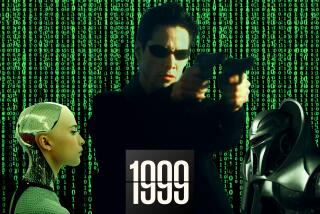Mike Cahill, Brit Marling and Michael Pitt on science of ‘I Origins’

“I guess you can call the movie sci-comma-fi as opposed to sci-dash-fi,” writer-director Mike Cahill said of his new film, “I Origins,” which continues his exploration of science as an engine for emotional storytelling. Building from ideas involving iris biometrics – eyes as a unique identifier – Cahill’s new film exists at the intersection of the headier (some might say trippier) aspects of modern science with all-too-human issues of identity, spirituality and love.
In the film, Dr. Ian Gray (Michael Pitt) is a scientist determined to give sightless worms the ability to see, jump-starting the process of evolution and thereby disproving the existence of God or intelligent design. While working intensely with his assistant-turned-lab-partner Karen (Brit Marling), his head and heart are turned by Sofi (Astrid Berges-Frisbey), a bohemian free-spirit. A few years later, Ian is with Karen, committed to each other and their work. Then a database of human eyes turns up a match to Sophie somewhere in India – a seeming impossibility that implies some divine intervention. Ian goes to India to find those mystery eyes.
“As an artist, you’re trying to transmit emotions to an audience, and the landscape, the frontiers, discovered by science are new lands to tell new stories in,” said Cahill of the connection he sees between science and storytelling.
The film opened last weekend in Los Angeles and New York and will be platforming to more cities. As part of the L.A. Times’ Indie Focus Screening Series, Cahill, Pitt and Marling appeared for a Q&A after a showing of “I Origins.”
In the freewheeling conversation, the trio spoke of the creative process behind the film. Cahill recalled photographing exactly 273 pairs of eyes for the film – “it’s all on a hard drive,” he said of the specific count – while also noting more than 200 visual effects shots are in the film.
Marling and Pitt recounted how the trio went to Johns Hopkins University in Baltimore to spend time with researchers there, learning the basics of working in a laboratory.
“I dropped somebody’s thesis in a petri dish, and it shattered,” Marling said. “We broke some hearts at Johns Hopkins.”
Joked Pitt: “I saw his heart shatter. She took like seven years of his life.”
“But for a good cause. It was a good movie, right?” countered Marling.
Marling and Cahill previously collaborated on “Another Earth,” directed by Cahill and co-written by the pair. That film supposed that a parallel planet just like ours existed elsewhere in the universe, an offshoot of the scientific ideas known as string theory.
While again investing a fantastical tale with undercurrents of real-life science, events in “I Origins” quite clearly cut the story between Dr. Ian Gray’s time with Sofi and his time with Karen. Yet, as Marling explained, the film avoids presenting one love as purer or truer than the other
“I think what’s cool is that the movie isn’t trying to be at all didactic on the subject of love,” said Marling. “I like that the movie doesn’t make a judgment. It’s just sort of presenting this man and the two great loves of his life.”
In the same way, the film leaves space for audiences to decide on the intervention of science or some higher power.
“I think some people will say it’s a very scientific film and others will say it’s a very spiritual film,” Pitt added.
The film has been a conversation starter since it premiered at the Sundance Film Festival this year. Critics have been sharply divided, with the Hollywood Reporter lauding it as a “venturesome, exploratory work,” while the New York Times chided it for “taking its daffy intellectual conceits far too seriously.”
With the film rolling out to theaters across the country, audiences have the chance to see it for themselves and enter into the earnest debate of the interface between science and spirituality.
Mike Cahill, two-time winner of the Alfred P. Sloan science-in-film prize at Sundance, revealed himself to be a man of the heart as well as the head. “I’m deeply romantic. I like to see what love is like.”
Follow Mark Olsen on Twitter: @IndieFocus
More to Read
Only good movies
Get the Indie Focus newsletter, Mark Olsen's weekly guide to the world of cinema.
You may occasionally receive promotional content from the Los Angeles Times.







